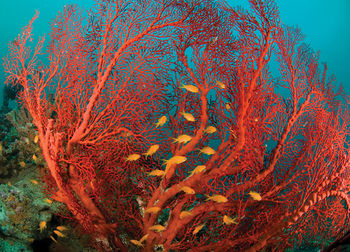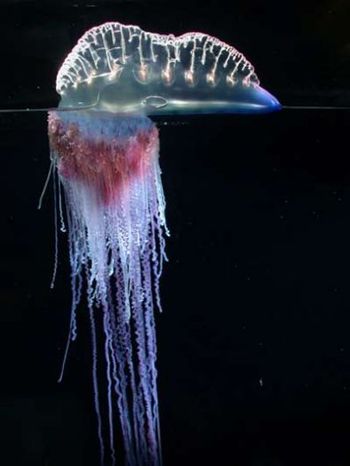Hydrozoans
Hydrozoans

Hydrozoans are individual predatory Cnidarians. Contrary to popular belief Hydrozoans fall within the kingdom Animalia. Almost all Hydrozoans are colonial creatures with a two stage life cycle, polyp and medusa. Due to an abundance of similarities in distribution, life cycle, variation, structure and appearance, hydrozoans are often mistaken for corals and jellyfish.
The polyp stage is stationary, and attaches to rock or other immobile substrate. While polyps can live individually, they are almost always aggregated into colonies. Some individuals like the Hydra never leave the polyp stage. Despite being very atypical of Hydrozoans as a whole, Hydras are the most widely known and researched of the group. Their lack of medusa stage, occurrence in fresh water, and solitary life are all rare for Hydrozoans.
Much like other other Cnidarians, hydrozoans exhibit a huge diversity of body types and life cycles. Most often they develop colonies, which can take on a few different forms.[2]

- Coral-like
- Unlike true corals which consist of many cells of an individual animal, Hydrozoan corals consist of individual members called Zooids that together function as a colonial animal.[3]
- Free floating
- Resemble jellyfish, actually a colony consisting of multiple groups of mature medusa

During reproduction polyps release free floating reproductive medusa.[4]
Distribution
Hydrozoans are found in every ocean around the world. While they are almost always found in salt water, some can be found in fresh water.
Symbiotic Relationships
- Zooxanthellae[5]
Reef Building
- Much like the Anthozoans, Hydrozoans often create a calcium enriched skeleton during their polyp stage
- Although they are so similar, it is believed that this calcification is a result of convergent evolution as opposed to an ancestral trait[3]
- As a group, Hydrozoans provide minimally to overall reef growth, but a few groups have played larger roles
- Milleporids
- During the Tertiary period milleporids such as Fire-Coral were responsible for massive changes in reef architecture
- These animals create a calcium carbonate (CaCO3) skeleton in which the microscopic polyps can live. This calcium carbonate skeleton is the visible part of the animal, and what gives the easy misconception that these Hyrozoans are true corals.[6]
- Milleporids
References
- ↑ 1.0 1.1 1.2 https://www.flickr.com/photos/carolinabio/4792715623/ Cite error: Invalid
<ref>tag; name "pic1" defined multiple times with different content Cite error: Invalid<ref>tag; name "pic1" defined multiple times with different content - ↑ http://www.ucmp.berkeley.edu/cnidaria/hydrozoa.html
- ↑ 3.0 3.1 Wood, Rachael “Reef-Building Sponges” American Scientist , Vol. 78, No. 3 (May-June 1990): pp. 224-235
- ↑ http://animaldiversity.ummz.umich.edu/accounts/Hydrozoa/
- ↑ http://sea.sheddaquarium.org/sea/fact_sheets.asp?id=93
- ↑ http://stevestonecoralreeffoundation.org/struct/reefarchitects1.html#cyathids
- ↑ http://www.accessscience.com/content/hydrozoa/331300